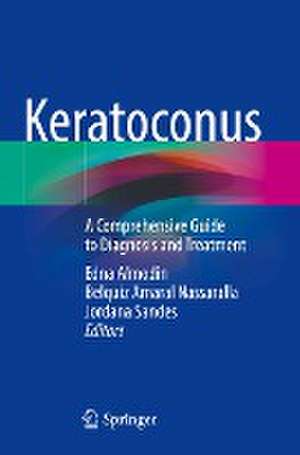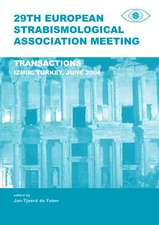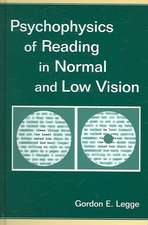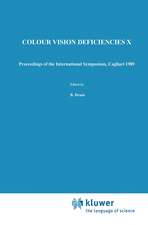Keratoconus : A Comprehensive Guide to Diagnosis and Treatment
Editat de Edna Almodin, Belquiz Amaral Nassaralla, Jordana Sandesen Limba Engleză Paperback – 28 oct 2023
Ophthalmologists will find a practical and useful approach of new technologies to get the best results for their patients. This book will really impact changes in the therapeutic conduct of corneal surgeons.
| Toate formatele și edițiile | Preț | Express |
|---|---|---|
| Paperback (1) | 1154.51 lei 38-44 zile | |
| Springer International Publishing – 28 oct 2023 | 1154.51 lei 38-44 zile | |
| Hardback (1) | 1507.92 lei 38-44 zile | |
| Springer International Publishing – 28 oct 2022 | 1507.92 lei 38-44 zile |
Preț: 1154.51 lei
Preț vechi: 1215.27 lei
-5% Nou
Puncte Express: 1732
Preț estimativ în valută:
220.97€ • 227.72$ • 186.55£
220.97€ • 227.72$ • 186.55£
Carte tipărită la comandă
Livrare economică 25 februarie-03 martie
Preluare comenzi: 021 569.72.76
Specificații
ISBN-13: 9783030853631
ISBN-10: 3030853632
Pagini: 1029
Ilustrații: XXXII, 1029 p. 473 illus., 456 illus. in color.
Dimensiuni: 155 x 235 mm
Greutate: 1.86 kg
Ediția:1st ed. 2022
Editura: Springer International Publishing
Colecția Springer
Locul publicării:Cham, Switzerland
ISBN-10: 3030853632
Pagini: 1029
Ilustrații: XXXII, 1029 p. 473 illus., 456 illus. in color.
Dimensiuni: 155 x 235 mm
Greutate: 1.86 kg
Ediția:1st ed. 2022
Editura: Springer International Publishing
Colecția Springer
Locul publicării:Cham, Switzerland
Cuprins
Part I. Keratoconus diagnosis
1. Clinical presentation and evolution of keratoconus
2. Natural Progression of Keratoconus
3. Prospective Biomarkers in Keratoconus
4. The Role of Thyroid Gland Dysfunction in the Development of Keratoconus
5. Eye Rubbing and Keratoconus
6. Early diagnosis of keratoconus: When should one suspect?
7. Algorithms and other gears for keratoconus Diagnosis 8. Corneal Topography for keratoconus Diagnosis
9. Pentacam for Keratoconus Diagnosis
10. Galilei™ for Keratoconus Diagnosis
11. Corneal Biomechanics in Keratoconus Diagnosis
12. Corneal Tomography and Biomechanical Integration
13. What is new in contrast sensitivity for keratoconus diagnosis
14. How to Follow the Patient after Keratoconus Diagnosis
15. Assessing Keratoconus Progression
16. Controversies in Keratoconus Diagnosis
17. Artificial intelligence in keratoconus diagnosis
Part II. Treatment
18. Preoperative Evaluation of Keratoconus
19. Keratoconus Treatment Flowchart
20. Drug Therapy in Keratoconus Patients
21. Step By Step in Performing Manifest Refraction and Tips in the Prescription of Glasses in Keratoconus Patients
22. Contact lenses in keratoconus - possibilities and flowchart
23. Soft Contact Lenses for Keratoconus. When to Indicate Them?
24. Rigid Gas Permeable Contact Lens Fitting in Keratoconus
25. Piggy Back With Contact Lenses for Keratoconus
26. Scleral and Mini Scleral Lenses for Patients With Keratoconus
27. What is new in contact lenses for keratoconus?
28. Contact Lens Fitting After Intracorneal Ring Segment Implantation
29. Contact lens fitting in Pellucid Marginal Degeneration
30. Contact Lens Fitting Following Corneal Graft Surgery
31. Corneal Cross-Linking: Indications and contraindications
32. Corneal Collagen Crosslinking Controversies
33. Intrastromal Cornealring Segments Implantation and Crosslinking: When and How?
34. Corneal Crosslinking Complications: How to Manage Them
35. Continued Long-Term Flattening After Corneal Crosslinking for Keratoconus
36. Corneal Cross-Linking: standard vs. accelerated protocols
37. Transepithelial Cross-linking
38. Cross-Linking in Ultra Thin Corneas
39. Corneal Cross-linking for Keratoconus in Childreen
40. Corneal Crosslinking in Down Syndrome Patients
41. The History of Ferrara Ring
42. Indications and contraindications
43. Ferrara Intrastromal Corneal Ring Segments Nomogram
44. Mediphacos Intrastromal Corneal Ring Segments Nomogram
45. Intracorneal ring segments implantation outcomes using two diferent manufactures’ nomograms for keratoconus surgery
46. Refractive and Visual Outcomes After Intacs And Other Intrastromal cornealring segments implantation according to the literature
47. ICRS Surgical Planning: An Easy and Objective Way
48. Intrastromal Corneal Rings Types
49. Long-Arc Intrastromal Corneal Ring Segment
50. Asymmetric intrastromal corneal rings
51. New Designs Of Asymmetric Rings
52. Ferrara HM: A New intrastromal Corneal Ring Segment Associated to Photorefractive keratectomy to Correct Moderate to High Myopia
53. Manual technique (golden tips)
54. Femtosecond laser-assisted technique. Peculiarities of the different types of Femtosecond lasers
55. Intrastromal Corneal Ring Segments After Corneal Graft Surgery
56. Postkeratoplasty astigmatism treatment by the association of Intrastromal Corneal Ring Segments (ICRS) and Photorefractive Keratectomy (PRK)
57. Intra-stromal Corneal Ring and Crosslinking for Treatment of Post Refractive Surgery Ectasia
58. Intrastromal Corneal Ring in Pellucid Marginal Degeneration and Pellucid-Like Keratoconus
59. ISCRS implantation in Keratoconus Children
60. Intra Corneal Ring implantation for early keratoconus
61. Intrastromal corneal ring segment (ICRS) implant to refractive and visual outcomes
62. Intra Corneal Ring Segment implantation for advanced keratoconus
63. Extreme Corneal Remodeling Using Intrastromal Corneal Ring Segments
64. Intra stromal corneal ring and PRK
65. Intrastromal corneal ring and CXL: When and How?
66. Intrastromal corneal ring and phakic lens
67. Association of Keratoconus treatment and phacoemulsification
68. Intrastromal Corneal Ring and Toric IOL
69. Intraocular lens Power Calculation in eyes with Keratoconus and Intrastomal Corneal Ring Segments implantation
70. Complications in intrastromal corneal Ring segments implantation
71. Refractive Lens Exchange With Small Aperture Intraocular Implants
72. Advanced surface ablation in Mild keratoconus
73. Redefining form fruste keratoconus
74. Indications and Contraindications for Corneal Transplantation in Keratoconus
75. DALK: Manual technique
76. DALK: How to achieve the bubble formation in all cases?
77. DALK Assisted by Femtosecond Laser
78. How to Deal With Type 2 bubble in DALK
79. DALK: How to Avoid Conversion to Penetrating Keratoplasty
80. Complications in Deep Anterior Lamellar Keratoplasty
81. Bowman's layer transplantation for keratoconus
82. Current indications of Penetrating Keratoconus Transplantation
83. High Ametropy Post Penetrating Keratoplasty
84. Acute Keratoconus treatment procedure (Descemetopasty)
Part III. Advances in keratoconus treatment
85. Femtosecond laser-assisted intrastromal corneal lenticule implantation for
treatment of advanced keratoconus 86. Corneal Epithelial Thickness Map in Keratoconus
87. Lenticular intrastromal keratoplasty for keratoconus
88. Intrastromal Corneal RIng Segments Combination for Refinement of Ametropia Correction
1. Clinical presentation and evolution of keratoconus
2. Natural Progression of Keratoconus
3. Prospective Biomarkers in Keratoconus
4. The Role of Thyroid Gland Dysfunction in the Development of Keratoconus
5. Eye Rubbing and Keratoconus
6. Early diagnosis of keratoconus: When should one suspect?
7. Algorithms and other gears for keratoconus Diagnosis 8. Corneal Topography for keratoconus Diagnosis
9. Pentacam for Keratoconus Diagnosis
10. Galilei™ for Keratoconus Diagnosis
11. Corneal Biomechanics in Keratoconus Diagnosis
12. Corneal Tomography and Biomechanical Integration
13. What is new in contrast sensitivity for keratoconus diagnosis
14. How to Follow the Patient after Keratoconus Diagnosis
15. Assessing Keratoconus Progression
16. Controversies in Keratoconus Diagnosis
17. Artificial intelligence in keratoconus diagnosis
Part II. Treatment
18. Preoperative Evaluation of Keratoconus
19. Keratoconus Treatment Flowchart
20. Drug Therapy in Keratoconus Patients
21. Step By Step in Performing Manifest Refraction and Tips in the Prescription of Glasses in Keratoconus Patients
22. Contact lenses in keratoconus - possibilities and flowchart
23. Soft Contact Lenses for Keratoconus. When to Indicate Them?
24. Rigid Gas Permeable Contact Lens Fitting in Keratoconus
25. Piggy Back With Contact Lenses for Keratoconus
26. Scleral and Mini Scleral Lenses for Patients With Keratoconus
27. What is new in contact lenses for keratoconus?
28. Contact Lens Fitting After Intracorneal Ring Segment Implantation
29. Contact lens fitting in Pellucid Marginal Degeneration
30. Contact Lens Fitting Following Corneal Graft Surgery
31. Corneal Cross-Linking: Indications and contraindications
32. Corneal Collagen Crosslinking Controversies
33. Intrastromal Cornealring Segments Implantation and Crosslinking: When and How?
34. Corneal Crosslinking Complications: How to Manage Them
35. Continued Long-Term Flattening After Corneal Crosslinking for Keratoconus
36. Corneal Cross-Linking: standard vs. accelerated protocols
37. Transepithelial Cross-linking
38. Cross-Linking in Ultra Thin Corneas
39. Corneal Cross-linking for Keratoconus in Childreen
40. Corneal Crosslinking in Down Syndrome Patients
41. The History of Ferrara Ring
42. Indications and contraindications
43. Ferrara Intrastromal Corneal Ring Segments Nomogram
44. Mediphacos Intrastromal Corneal Ring Segments Nomogram
45. Intracorneal ring segments implantation outcomes using two diferent manufactures’ nomograms for keratoconus surgery
46. Refractive and Visual Outcomes After Intacs And Other Intrastromal cornealring segments implantation according to the literature
47. ICRS Surgical Planning: An Easy and Objective Way
48. Intrastromal Corneal Rings Types
49. Long-Arc Intrastromal Corneal Ring Segment
50. Asymmetric intrastromal corneal rings
51. New Designs Of Asymmetric Rings
52. Ferrara HM: A New intrastromal Corneal Ring Segment Associated to Photorefractive keratectomy to Correct Moderate to High Myopia
53. Manual technique (golden tips)
54. Femtosecond laser-assisted technique. Peculiarities of the different types of Femtosecond lasers
55. Intrastromal Corneal Ring Segments After Corneal Graft Surgery
56. Postkeratoplasty astigmatism treatment by the association of Intrastromal Corneal Ring Segments (ICRS) and Photorefractive Keratectomy (PRK)
57. Intra-stromal Corneal Ring and Crosslinking for Treatment of Post Refractive Surgery Ectasia
58. Intrastromal Corneal Ring in Pellucid Marginal Degeneration and Pellucid-Like Keratoconus
59. ISCRS implantation in Keratoconus Children
60. Intra Corneal Ring implantation for early keratoconus
61. Intrastromal corneal ring segment (ICRS) implant to refractive and visual outcomes
62. Intra Corneal Ring Segment implantation for advanced keratoconus
63. Extreme Corneal Remodeling Using Intrastromal Corneal Ring Segments
64. Intra stromal corneal ring and PRK
65. Intrastromal corneal ring and CXL: When and How?
66. Intrastromal corneal ring and phakic lens
67. Association of Keratoconus treatment and phacoemulsification
68. Intrastromal Corneal Ring and Toric IOL
69. Intraocular lens Power Calculation in eyes with Keratoconus and Intrastomal Corneal Ring Segments implantation
70. Complications in intrastromal corneal Ring segments implantation
71. Refractive Lens Exchange With Small Aperture Intraocular Implants
72. Advanced surface ablation in Mild keratoconus
73. Redefining form fruste keratoconus
74. Indications and Contraindications for Corneal Transplantation in Keratoconus
75. DALK: Manual technique
76. DALK: How to achieve the bubble formation in all cases?
77. DALK Assisted by Femtosecond Laser
78. How to Deal With Type 2 bubble in DALK
79. DALK: How to Avoid Conversion to Penetrating Keratoplasty
80. Complications in Deep Anterior Lamellar Keratoplasty
81. Bowman's layer transplantation for keratoconus
82. Current indications of Penetrating Keratoconus Transplantation
83. High Ametropy Post Penetrating Keratoplasty
84. Acute Keratoconus treatment procedure (Descemetopasty)
Part III. Advances in keratoconus treatment
85. Femtosecond laser-assisted intrastromal corneal lenticule implantation for
treatment of advanced keratoconus 86. Corneal Epithelial Thickness Map in Keratoconus
87. Lenticular intrastromal keratoplasty for keratoconus
88. Intrastromal Corneal RIng Segments Combination for Refinement of Ametropia Correction
Notă biografică
Edna Almodim, MD is currently director of the Provision Eye Hospital of Maringá, PR, Brazil and the Brazilian Society of Cataract and Intraocular Implants general secretary and Member of the Brazilian Society of Cataract and Refractive Surgery Deliberative Council. She is a former president of Brazilian Society of Administration in Ophthalmology (SBAO) and the founder of the Umuarama Eye Bank. In 2019, she was elected president of the Brazilian Society of Ophthalmology. Dr. Almodin has a great experience in Ophthalmology, especially in the field of cataract surgery, refractive surgery, keratoconus, high myopia, and strabismus. She has been invited to speak and teach several national and international meetings. Belquiz Amaral Nassaralla, BSc, MD, PhD has a Bachelor Degree in Biomedical Sciences (1980) and Licentiate Degree in Biology (1983), from the University of Brasilia. She holds a fellowship in Cornea and External Eye Diseases at the Hilton Rocha Institute (1991), fellowship in Oculoplastic Surgery at the Hilton Rocha Institute (1992), and a research fellowship in Cornea and Refractive Surgery at the University of Southern California / Doheny Eye Institute, USA (1994). In 2000, Dr. Nassaralla holds her Ph.D. in Ophthalmology from the Federal University of Minas Gerais. She has published several international peer-reviewed journal articles and 32 book or book chapters. She is a Consultant Ophthalmic Surgeon at the Goiania Eye Institute with sub-specialties in Cornea, Refractive Surgery, Cataract Surgery, External Eye Diseases and Plastic Eye Surgery. She has been invited to speak and teach several national and international meetings and has won awards for her contribution.
Jordana Sandes Barbosa, MD, PhD completed a cornea and external eye diseases fellowship at the Federal University of Goias (2010-2012) and received her specialist degree in ophthalmology from the Brazilian Medical Association (AMB), Brazilian Council of Ophthalmology (CBO). She holds her master's degree in Health Sciences at the Federal University of Goias (2014-2016) and her PhD in Health Sciences at the same institution (2017-2021). She is a preceptor member of the cornea department at the Federal University of Goias. Dr Jordana is co-director of the Bueno Medical Center Oftalmologia and also works as ophthalmologist at the Núcleo de Medicina Ocular. She has experience in the field of Ophthalmology with emphasis on cataracts, cornea, keratoconus and external eye diseases. Dr. Jordana is heavily involved in the practice and research of keratoconus management and has published several peer-reviewed articles in the field. She has been invited to speak and teach several national and international meetings.
Jordana Sandes Barbosa, MD, PhD completed a cornea and external eye diseases fellowship at the Federal University of Goias (2010-2012) and received her specialist degree in ophthalmology from the Brazilian Medical Association (AMB), Brazilian Council of Ophthalmology (CBO). She holds her master's degree in Health Sciences at the Federal University of Goias (2014-2016) and her PhD in Health Sciences at the same institution (2017-2021). She is a preceptor member of the cornea department at the Federal University of Goias. Dr Jordana is co-director of the Bueno Medical Center Oftalmologia and also works as ophthalmologist at the Núcleo de Medicina Ocular. She has experience in the field of Ophthalmology with emphasis on cataracts, cornea, keratoconus and external eye diseases. Dr. Jordana is heavily involved in the practice and research of keratoconus management and has published several peer-reviewed articles in the field. She has been invited to speak and teach several national and international meetings.
Textul de pe ultima copertă
Keratoconus is a progressive disease of the cornea which can lead to blindness as irregular astigmatism increases. The study of the ectasic diseases of the cornea has evolved considerably in the last several years and this has brought new tools for the keratoconus diagnosis and treatment. A better understanding of treatment options can enhance visual rehabilitation and prevent blindness in these patients.
This book provides the reader deeply and updated information on keratoconus treatment. Written by experts from worldwide, presents clinical, genetic, metabolic and biomechanical aspects in the development of the disease, the proper intervention time, the imaging tests used for diagnosis and keratoconus monitoring, as well as details new surgical procedures (as contact lenses and laser technologies) using modern methods with wide technological application. Two pioneers in the keratoconus treatment bring their valuable contribution in specific chapters.
Ophthalmologists will find a practical and useful approach of new technologies to get the best results for their patients. This book will really impact changes in the therapeutic conduct of corneal surgeons.
Ophthalmologists will find a practical and useful approach of new technologies to get the best results for their patients. This book will really impact changes in the therapeutic conduct of corneal surgeons.
Caracteristici
Provides updated information on keratoconus treatment
Details new surgical procedures with wide technological application
Presents the advantages and main differences between lasers technologies for keratoconus treatment
Details new surgical procedures with wide technological application
Presents the advantages and main differences between lasers technologies for keratoconus treatment





















